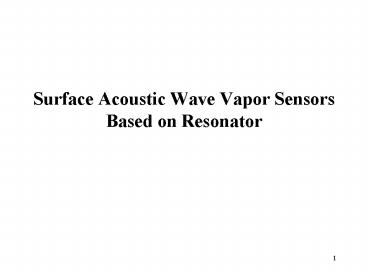Surface Acoustic Wave Vapor Sensors Based on Resonator PowerPoint PPT Presentation
1 / 18
Title: Surface Acoustic Wave Vapor Sensors Based on Resonator
1
Surface Acoustic Wave Vapor Sensors Based on
Resonator
2
Introduction
- Wohltjen, 1979
- Mass loading
- S (change in signal)/(change in analyte
concentration) - SAW resoator sensors have lower noise levels and
hence yield lower detection limits than delay
line sensors
3
- ZnO/Si resonators for organic vapor detection
(Martin) - 200 MHz quartz SAW resonators (Bowers)
4
- Sensors 200, 300, and 400 MHz quartz SAW
resonators - Coating methods LB method and spray-coating
5
Experimental
- Coating material poly(vinyle tetradecanal)
- SAW resonators 200, 300, and 400 MHz two-port
SAW resonator(500 refectors) on ST-cut quartz
Al IDTs (split, 50?) SiO2 overcoat - All devices have the same path length (10 ?) and
aperture (65 ?) - 4 pin round TO-6 headers, Au wire bonding
- Temperature 25oC
6
- SAW delay lines 158 MHz SAW dual delay lines on
ST-cut quartz Al IDTs SiO2 overcoat - TO-8 header
7
- Frequency data collection
- resolution of 0.02 Hz for resonators
- resolution of 2 Hz for dual delay lines
- noise measurement 4 min at 10 points/min, stand
deviation of the residuals of the linear
least-squares line - baseline noise10 min at 5 points/min before
vapor exposure
8
- Mass sensitivity determination
- flow rate 120 mL/min
- the device was returned to the board and allowed
to stabilize for at least an hour - sensor was firstly exposed to clean carrier gas
for 45 min - clean carrier gas (45 min)? vapor (5 min)? clean
carrier gas (10 min)? vapor (5 min) ? clean
carrier gas (10 min) ? control experiment(clean
carrier gas, 75 min)
9
Results and discussionMass sensitivities
- For soft materials(rubbery amorphous polymers,
??107 dyn/cm2, ??1 g/cm3), the second term is
negligible - For stiffer materials(glassy amorphous polymers,
?1010 dyn/cm2, ??1 g/cm3), the second term is
10-15 of the absolute value of the first term
10
- Choice of a polymer coating
- the material is suitable for deposition by the LB
method - the material is above its static glass transition
temperature at RT - the material is a sorbent for organic vapors
11
(No Transcript)
12
Vapor sensitivities
- The strength of sorption is dependent on the
choice of the sorbent material and the sensors
operation temperature - The vapor sensitivity is determined by the
coating thickness, the partition coefficient, and
physical properties of the film during sorption
13
- The coating thickness that can be applied without
quenching oscillation will decrease as the device
frequency is increased - The coating thickness producing more than 500-600
kHz of frequency shift damp out the oscillator
14
- The higher frequency devices tolerate less
coating than lower frequency devices - If SAW sensors of various frequencies are all
coated with the same material to the same degree
of frequency shift, then their vapor
sensitivities should be identical
15
(No Transcript)
16
(No Transcript)
17
- Interfacial adsorption bulk adsorption
- Interfacial adsorption vapor is absorbed at
polymer/solid, gas/ polymer, and gas/solid - The interfacial adsorption increases with
frequency increasing - The principle mechanism for sensor response is
bulk absorption of vapor into the film
18
Noise and detection limits
- The limiting factor in the noise is the quartz
chip rather than the oscillator electronics - Thermal conditions play a key role in determining
noise levels - The 300 and 400 MHz resonators are noiser than
200 MHz resonator - The worst noise levels on 200 MHz resonator are
well below the worst levels on delay lines - The lowest deiection limits is achieved with the
lowest noise device

